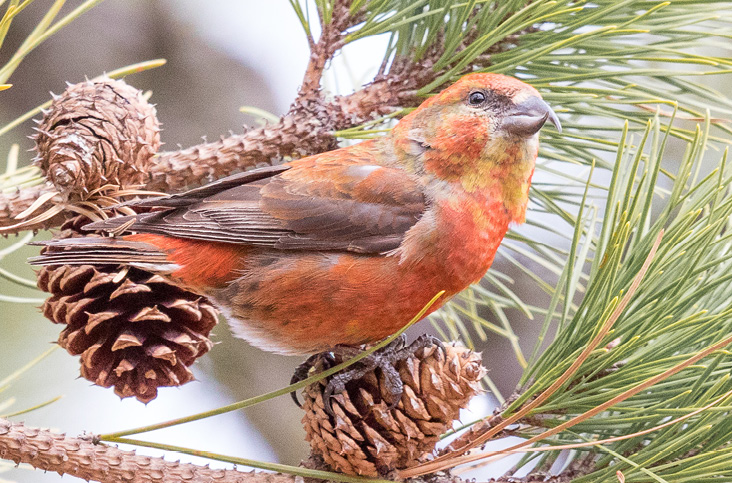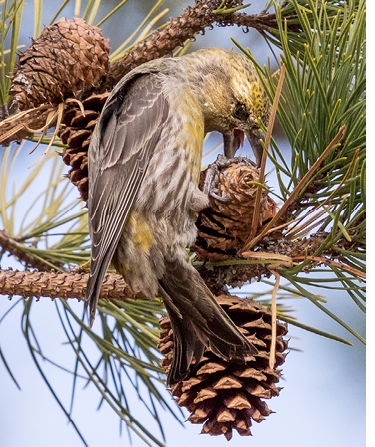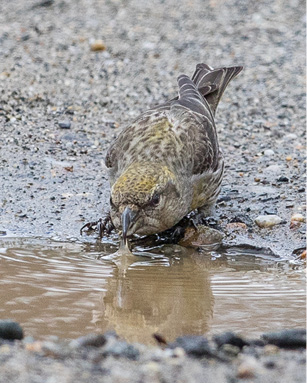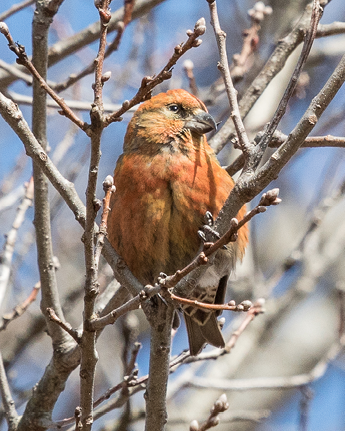Jeremy Coleman and Tim Spahr

Male Red Crossbill in a Pitch Pine; still molting into adult plumage (April). All photographs taken at Montague Sand Plains; all photographs © Jeremy Coleman.
Introduction
The nomadic Red Crossbill (Loxia curvirostra) can appear in numbers in one particular region only to disappear in subsequent years. Crossbill movements are irruptive and follow the cone crop, with various North American crossbill groups—flight call types—favoring the conifer species to which they are best adapted by bill size and shape. A recent article by Young and Spahr (2017) has called attention to the potential for a significant irruption of Red Crossbills throughout large portions of North America beginning in the fall of 2017. In Massachusetts, this irruption could extend throughout the winter of 2017–2018 and into the spring of 2018.
Early work by Groth (1993) and continuing research by others (Benkman 1993, 2009; Benkman et al. 2009; Parchman and Benkman 2009) initially resulted in the identification of 11 distinct Red Crossbill call types in North and Central America. Now that Type 9 has been elevated to species status as the Cassia Crossbill (Loxia sinesciurus) (Chesser et al. 2017), 10 call types remain. Although difficult to impossible to differentiate visually, each type can be reliably identified from recordings of its flight call—the emphatic jip-jip-jip calls heard when the birds are flying overhead and occasionally given by perched birds as well—but not by their songs or other vocalizations. When encountering crossbills in the field, one can record the flight calls using the built-in microphone of a smart phone. When embedded into an eBird report, such recordings allow identification to type by others. The report can then be updated to reflect call type. If any additional call types are split off as new species in the future, this split would be updated in one's eBird account. For additional, useful information on recording flight calls as well as comprehensive descriptions of the various call types, their characteristics and habitats, refer to Young and Spahr (2017).
There has been discussion of splitting the remaining 10 flight call types into species, but more work is needed before such a change would be scientifically justified. Red Crossbill speciation and call types are a rich area of research and one where birders can make a significant contribution by recording and reporting flight calls.

Female Red Crossbill extracting seeds in Pitch Pine.
The last major irruption of Red Crossbills into the Northeast occurred in 2012 when western flight call Types 3 and 7 or 10 were seen in large numbers in the eastern states. During this 2012–2013 irruption, there were dozens of crossbills seen in many coastal locations in Massachusetts, Rhode Island, New York, and even as far south as New Jersey and Virginia. The winter of 2017–2018 could deliver an irruption surpassing that of five years ago. In part due to drought conditions followed by a wet spring and summer in the Northeast, this year's cone crop has the potential to be a once-in-a-few-decades event, with native spruces, white, pitch and red pines, hemlock, and tamarack all showing bumper cone crops. In addition, an epic cone crop failure in the Rockies is driving birds out of their normal wintering ranges. As of this writing in December 2017, there are massive numbers of Red Crossbills spreading across the country, including many western flight call types showing up in the plains states, Great Lakes states, and along the Pacific coast from California to Alaska. Crossbills are even frequenting small stands of pines in the lowlands of the desert Southwest.
Natural History
Red Crossbills have evolved a specialized, crossed bill specific to extracting the seeds from conifer cones, and their dependence on the cone crop is the underlying key to their natural history. Irruptions can bring flocks all the way across North America in search of suitably heavy crops. The species is unique in that nesting is closely tied to food availability, not necessarily to season. Crossbills in North America breed primarily in two cycles, one in summer (July through early September) when newly-developed, ripening cone crops are present, and again in winter-spring (January through early May), coinciding with the last of the remaining good cones. No nests or nestlings of Red Crossbills have ever been found in October or November in North America, though they have been found in Europe during these months. There are, however, many North American records of juvenile-plumaged birds in October and November. Matt Young of the Cornell Lab of Ornithology, who has been researching crossbills for 20 years, notes that these autumn observations of Red Crossbills in juvenile plumage may have given rise to the notion that North American crossbills can nest at any time of the year.

Female drinking; had been picking up gravel from road.
The female incubates a clutch of typically three eggs, with the male bringing food for the female and later for the hatched chicks. Both parents bring food to the chicks beginning four or five days after hatching, feeding them regurgitated seeds. The young fledge after 18 to 22 days, but it takes a bit longer for their bills to develop sufficiently to extract cone seeds, so there is a short period when the fledged birds are dependent on their parents. In addition to cone seeds, food sources include the buds of deciduous trees, berries, and insects. Crossbills can also be seen on dirt roads picking up gravel and salt. Gravel grit aids in digesting vegetable material, and the ingestion of salt may be related to a calcium deficiency in their diet (Tozer 1994).
Birds that hatch in summer molt in late summer or fall, coinciding with the fall molt of adult birds. However, it's not uncommon to see birds in a suspended molt for several months. Birds that hatch in late winter or spring molt about three months after hatching, and then again during the fall molt period. Juvenile plumages are thus seen over an extended time period.
Red Crossbill Speciation
It is unusual that a single avian species should have so many distinct, differentiable population types. Research by Parchman and Benkman (2002) and others suggests an explanation. Cone crops and crossbill populations seem to be engaged in an "evolutionary arms race" that has led to the creation of specialized bill types, particularly in the western United States where isolated ranges of lodgepole pine create biogeographical islands in which crossbills and cones have co-evolved, and continue to do so (Benkman, 2009). This dynamic led to the evolution of the Cassia Crossbill. Rocky Mountain lodgepole pines (Pinus contorta latifolia) in the "islands" of southern Idaho—where Cassia Crossbills are found—developed larger, thicker-scaled cones than in nearby ranges. This potential food source, in turn, favored the development of larger-billed crossbills and the evolution of the newly recognized species. That this phenomenon may be ongoing elsewhere is a particularly interesting focus of researchers, giving us a chance to observe natural selection in action before our very eyes!

Male feeding on deciduous buds.
Recent Red Crossbill history in Massachusetts
In the winter and spring of 2016–2017, there were small concentrations of Red Crossbills in Massachusetts reported from two regions, Salisbury Beach and Plum Island in the east and the Montague Sand Plains in central Massachusetts. Of the many reports to eBird from the former area, only one recording was reported, for the small- to medium-billed Sitka spruce crossbill—Type 10 or possibly Type 7. The primary range for call Type 10 is the coastal Pacific Northwest, from Northern California into central Oregon; Type 7 possibly is endemic from central to northeastern Canada. In the Montague Sand Plains, the Sitka spruce type was recorded along with the large-billed ponderosa pine crossbill, Type 2. Type 2 crossbills are most common in the ponderosa pine forests of the West, but can be found continent-wide in stands of hard-coned pines, including red and pitch pines of the Northeast.
The last reported summer sightings were on June 4 in the Sand Plains and July 31 in the Salisbury and Plum Island region. Breeding in Massachusetts was certainly possible, and even suggested, but unfortunately not documented. Elsewhere in the Northeast, crossbills were noted and confirmed as breeding in New York, New Hampshire, and Maine, as well as in southern Ontario and Quebec in Canada. In addition to Type 10, Appalachian or Type 1 birds were confirmed breeding near Type 10s in New Hampshire and New York.
Where to Look in Massachusetts and the Northeast
The 2017–2018 invasion is well underway. Western flight call Types 2, 3, 4, and even 5 were moving east as early as July and August. By November, the irruption in the plains states was widespread, with birds common in Texas northward through the Dakotas, and eastward into Missouri, Indiana, Ohio, Michigan, Wisconsin, and Minnesota. In the Northeast, a few Type 1, 3, and 10 birds have been recorded in New Hampshire and Maine recently, with some Type 10 and untyped birds trickling into Massachusetts and Vermont beginning in late November. Given the failure of the cone crop in the West, and the general dearth of cone-producing trees in the plains and Midwest, it is inevitable that crossbills will continue to arrive in the Northeast. Will they make it south, or stay north where the cone crop seems to be good as well? The abundance of cones throughout the Northeast and north into Canada may result in a wide dispersion of birds, making them harder to locate.
In Massachusetts the cone crop is good in most locations, and crossbills may appear anywhere with cones. Historically good locations have been Salisbury Beach State Reservation and the Plum Island area. Miles Standish State Forest and Cape Cod also have substantial pine forests and can hold birds. Inland and west, any substantial grove of Norway spruce, hemlocks, or cone-laden pines, such as the pitch pines in the Montague Sand Plains, could hold crossbills. Other areas likely to host birds include coniferous forests in Savoy and Windsor, and the October Mountain State Forest northeast of Lee. These areas in central and western Massachusetts may be bigger players this year because of their large cone crops, but given the nomadic nature of the birds, and their ability to fly long distances, lots of searching may be required to find them. The challenge of finding birds this year—and recording their flight calls—is a great opportunity for citizen science to contribute to the exciting, ongoing research into this interesting species.
References
- Benkman, C. W. 1993. Adaptation to single resources and evolution of crossbill (Loxia) diversity. Ecological Monographs 63: 305–325.
- Benkman, C. W. 2009. Diversifying Coevolution between Crossbills and Conifers. Evolution: Education and Outreach. 3: 47–53.
- Benkman, C. W., J. W. Smith, P. C. Keenan, T. L. Parchman, and L. Santisteban. 2009. A new species of Red Crossbill (Fringillidae: Loxia) from Idaho. Condor 111: 169–176.
- Chesser, R.T., K. J. Burns, C. Cicero, J. L. Dunn, A. W. Kratter, I. J. Lovette, P. C. Rasmussen, J. V. Remsen, Jr., J. D. Rising, D. F. Stotz, and K. Winker. 2017. Fifty-eighth supplement to the American Ornithological Society's Check-list of North American Birds. The Auk 134: 751–773.
- Groth, J. G. 1993. Evolutionary differentiation in morphology, vocalizations and allozymes among nomadic sibling species in the North American Red Crossbill (Loxia curvirostra) complex. University of California Publications in Zoology 127: 1–143.
- Parchman, T. L., and C. W. Benkman. 2002. Diversifying coevolution between crossbills and black spruce on Newfoundland. Evolution 56: 1663–1672.
- Tozer, R. 1994. Red Crossbills Feeding at Mineral Sources. Ontario Birds 12: 102–108. Accessed December 6, 2017 at: https://sora.unm.edu/sites/default/files/102-108OB Vol12%233 Dec1994.pdf
- Young, M., and T. Spahr. 2017. Crossbills of North America: Species and Red Crossbill Call Types. eBird 11 October, 2017. Available online at: http://ebird.org/content/ebird/news/crossbills-of-north-america-species-and-red-crossbill-call-types/
Jeremy Coleman is an architect who has recently moved to Shelburne Falls, Massachusetts, from Brattleboro, Vermont. His interests include photography, birding, and exploring the natural landscape.
Tim Spahr runs a scientific consulting company focused on asteroid science. When not working, Tim can be found in and around Worcester County, Massachusetts, chasing warblers and Red Crossbills if they are nearby.